The MSP1 gene is necessary to restrict the number of cells entering into male and female sporogenesis and to initiate anther wall formation in rice
- PMID: 12897248
- PMCID: PMC167165
- DOI: 10.1105/tpc.012401
The MSP1 gene is necessary to restrict the number of cells entering into male and female sporogenesis and to initiate anther wall formation in rice
Abstract
The function of the novel gene MSP1 (MULTIPLE SPOROCYTE), which controls early sporogenic development, was elucidated by characterizing a retrotransposon-tagged mutation of rice. The MSP1 gene encoded a Leu-rich repeat receptor-like protein kinase. The msp1 mutation gave rise to an excessive number of both male and female sporocytes. In addition, the formation of anther wall layers was disordered and the tapetum layer was lost completely. Although the mutation never affected homologous chromosome pairing and chiasma maintenance, the development of pollen mother cells was arrested at various stages of meiotic prophase I, which resulted in complete male sterility. Meanwhile, plural megaspore mother cells in a mutant ovule generated several megaspores, underwent gametogenesis, and produced germinable seeds when fertilized with wild-type pollen despite disorganized female gametophytes. In situ expression of MSP1 was detected in surrounding cells of male and female sporocytes and some flower tissues, but never in the sporocytes themselves. These results suggest that the MSP1 product plays crucial roles in restricting the number of cells entering into male and female sporogenesis and in initiating anther wall formation in rice.
Figures

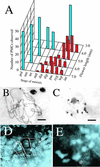

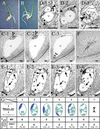
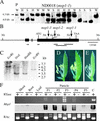
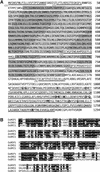
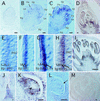
Similar articles
-
OsTDL1A binds to the LRR domain of rice receptor kinase MSP1, and is required to limit sporocyte numbers.Plant J. 2008 May;54(3):375-87. doi: 10.1111/j.1365-313X.2008.03426.x. Epub 2008 Jan 31. Plant J. 2008. PMID: 18248596 Free PMC article.
-
The rice gene DEFECTIVE TAPETUM AND MEIOCYTES 1 (DTM1) is required for early tapetum development and meiosis.Plant J. 2012 Apr;70(2):256-70. doi: 10.1111/j.1365-313X.2011.04864.x. Epub 2012 Jan 5. Plant J. 2012. PMID: 22111585
-
The novel gene HOMOLOGOUS PAIRING ABERRATION IN RICE MEIOSIS1 of rice encodes a putative coiled-coil protein required for homologous chromosome pairing in meiosis.Plant Cell. 2004 Apr;16(4):1008-20. doi: 10.1105/tpc.020701. Epub 2004 Mar 18. Plant Cell. 2004. PMID: 15031413 Free PMC article.
-
Rice anther tapetum: a vital reproductive cell layer for sporopollenin biosynthesis and pollen exine patterning.Plant Biol (Stuttg). 2023 Mar;25(2):233-245. doi: 10.1111/plb.13485. Epub 2022 Dec 16. Plant Biol (Stuttg). 2023. PMID: 36350096 Review.
-
Pre-meiotic anther development.Curr Top Dev Biol. 2019;131:239-256. doi: 10.1016/bs.ctdb.2018.11.001. Epub 2018 Nov 30. Curr Top Dev Biol. 2019. PMID: 30612619 Review.
Cited by
-
Gene, protein, and network of male sterility in rice.Front Plant Sci. 2013 Apr 11;4:92. doi: 10.3389/fpls.2013.00092. eCollection 2013. Front Plant Sci. 2013. PMID: 23596452 Free PMC article.
-
Control of anther cell differentiation: a teamwork of receptor-like kinases.Sex Plant Reprod. 2009 Dec;22(4):221-8. doi: 10.1007/s00497-009-0106-3. Epub 2009 Aug 6. Sex Plant Reprod. 2009. PMID: 20033443 Review.
-
Control of female gamete formation by a small RNA pathway in Arabidopsis.Nature. 2010 Mar 25;464(7288):628-32. doi: 10.1038/nature08828. Epub 2010 Mar 7. Nature. 2010. PMID: 20208518 Free PMC article.
-
Epigenetic control of cell specification during female gametogenesis.Sex Plant Reprod. 2011 Jun;24(2):137-47. doi: 10.1007/s00497-011-0166-z. Epub 2011 Apr 12. Sex Plant Reprod. 2011. PMID: 21484604 Review.
-
Functional analysis of sporophytic transcripts repressed by the female gametophyte in the ovule of Arabidopsis thaliana.PLoS One. 2013 Oct 23;8(10):e76977. doi: 10.1371/journal.pone.0076977. eCollection 2013. PLoS One. 2013. PMID: 24194852 Free PMC article.
References
-
- Bhojwani, S.S., and Bhatnagar, S.P. (1992). The Embryology of Angiosperms. (New Delhi: Vikas Publishing House).
-
- Canales, C., Bhatt, A.M., Scott, R., and Dickinson, H. (2002). EXS, a putative LRR receptor kinase, regulates male germline cell number and tapetal identity and promotes seed development in Arabidopsis. Curr. Biol. 12, 1718–1727. - PubMed
-
- Chapman, G.P. (1987). The tapetum. Int. Rev. Cytol. 107, 111–125.
-
- Chaubal, R., Zanella, C., Trimnell, M.R., Fox, T.W., Albertsen, M.C., and Bedinger, P. (2000). Two male-sterile mutants of Zea mays (Poaceae) with an extra cell division in the anther wall. Am. J. Bot. 87, 1193–1201. - PubMed
-
- Clark, S.E. (2001). Cell signalling at the shoot meristem. Nat. Rev. Mol. Cell Biol. 2, 276–284. - PubMed
Publication types
MeSH terms
Substances
Associated data
- Actions
- Actions
- Actions
- Actions
LinkOut - more resources
Full Text Sources
Other Literature Sources
Molecular Biology Databases
Research Materials

